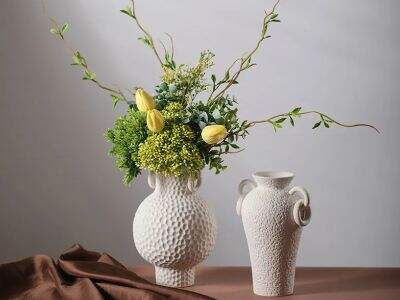Ilan sa mga salita:
Kamusta, mga kasamahan sa kalikasan. Nagtataka kung ano ang mga sangkap na ginawa sa magagarang ceramic pots na nakikita mo sa malalaking mesa sa hardin at bahay? Kaya ngayon ay matutulan natin ang tungkol sa ceramic pottery at sa iba't ibang sangkap na nagdedetermine kung paano ginawa ang mga magagarang plato. Kaya't mag relax ka na lang, at tara na at ipakita ko sa iyo ang ganda ng ceramic flower pots.
Luad at Tubig:
Mayroong dalawang pangunahing sangkap para sa mga ceramic flower pot: ang una ay luwad. Ang luwad ay malambot na kumakapit na lupa at kapag basa, maaaring hubugin sa anyo ng mga bagay at patuyuin at pagkatapos ay isunog upang makagawa ng matigas na materyal. Ito ay kinokolekta sa mga tibok mula sa lupa para sa paggawa ng palayok. Dagdag na tubig ang ginagamit kasama ng luwad upang ang halo ay maging madaling iporma. Ang luwad at tubig ay pinagsasama upang makagawa ng isang homogenous, maaaring hubugin na materyal na maaaring anyoan at hugis, halimbawa, sa anyo ng mga palayok.
Papel ng Buhangin at Quartz:
Hindi lamang luwad, ang buhangin at quartz ay nagsisilbing mahahalagang sangkap sa paggawa ng ceramic flower pots ang pinaghalong ito ay pinagsama-sama sa buhangin upang pigilan ang pagbitak o pag-urong ng luwad habang tumutuyo at sinusunog. Ang kuwarts, gayunpaman, ay isang mineral at naglilingkod lamang upang magdagdag ng lakas at tibay sa tapos na produkto. Ang buhangin at kuwarts ay nagtutulungan sa luwad upang makabuo ng isang matibay at matagalang palayok na yari sa luwad na magtatagal sa mga panahon.
Mga Oxide at Pigmento:
Ceramic flower pots ay madalas na kinukulayan gamit ang oxides o pigment. Ang oxides ay mga likas na nagaganap na compound na maaaring pagsamahin sa timpla ng luwad upang makalikha ng tiyak na kulay, halimbawa ay pula, dilaw, o asul. Ang pigment naman ay mga artipisyal na kulay na kadalasang inilalapat sa ibabaw ng palayok bago ipapaso. Gamit ang oxides at pigment, maari ng isang ceramic artist na makagawa ng kamangha-manghang, makukulay na disenyo na magpapahiwatig at magpapaganda sa bawat paso.
Glazes at Kiln Firing:
Pagkatapos ng paghubog, kulayan at pagpapatuyo sa isang paso, panahon na upang makuha ang ninanais na kulay gamit ang ceramic glazes. Ang glazes ay likidong pang-ibabaw na inaabray sa labas ng paso upang mapakinis at mapaganda ang ibabaw nito. Kaya't, bukod sa maganda, ito ay nagpoprotekta rin laban sa mga elemento na dumarating kasama ang pinsala ng tubig. Ang proseso ng pagpapaso ay nangyayari kapag inilagay ang paso sa kweba pagkatapos ng glazing. Ang pagpapaso sa kweba ay magpapainit sa paso sa napakataas na temperatura na kinakailangan upang vitrify ang luwad, gawin itong matigas at malakas, at itakda ang glazes.
Mga Opsyon na Sintetiko at Friendly sa Kalikasan:
Habang tradisyonal ceramic flower pots ay gawa sa mga natural na materyales tulad ng luwad at buhangin, maaari rin silang maging sintetiko o eco-friendly. Ang sintetikong palayok ay isang produkto na gawa ng tao na mukhang katulad at pakiramdam ay parang natural na luwad. Karaniwan din silang mas magaan at mas matibay kaysa sa tradisyonal na palayok na ceramic. Ang eco ceramic pots naman, ay gawa sa mga hindi nakakalason, naa-recycle na materyales na may pinakamaliit na epekto sa kalikasan. Ang mga palayok na ito ay nabubulok at maaaring i-recycle, mainam para sa mga gardener na may pangangalaga sa kalikasan.

 EN
EN
 AR
AR
 HR
HR
 CS
CS
 DA
DA
 NL
NL
 FI
FI
 FR
FR
 DE
DE
 EL
EL
 IT
IT
 JA
JA
 KO
KO
 NO
NO
 PL
PL
 PT
PT
 RO
RO
 RU
RU
 ES
ES
 SV
SV
 TL
TL
 ID
ID
 LT
LT
 SK
SK
 SL
SL
 SQ
SQ
 ET
ET
 HU
HU
 MT
MT
 FA
FA
 AF
AF
 MS
MS
 GA
GA
 IS
IS
 MK
MK
 HY
HY
 AZ
AZ
 KA
KA

